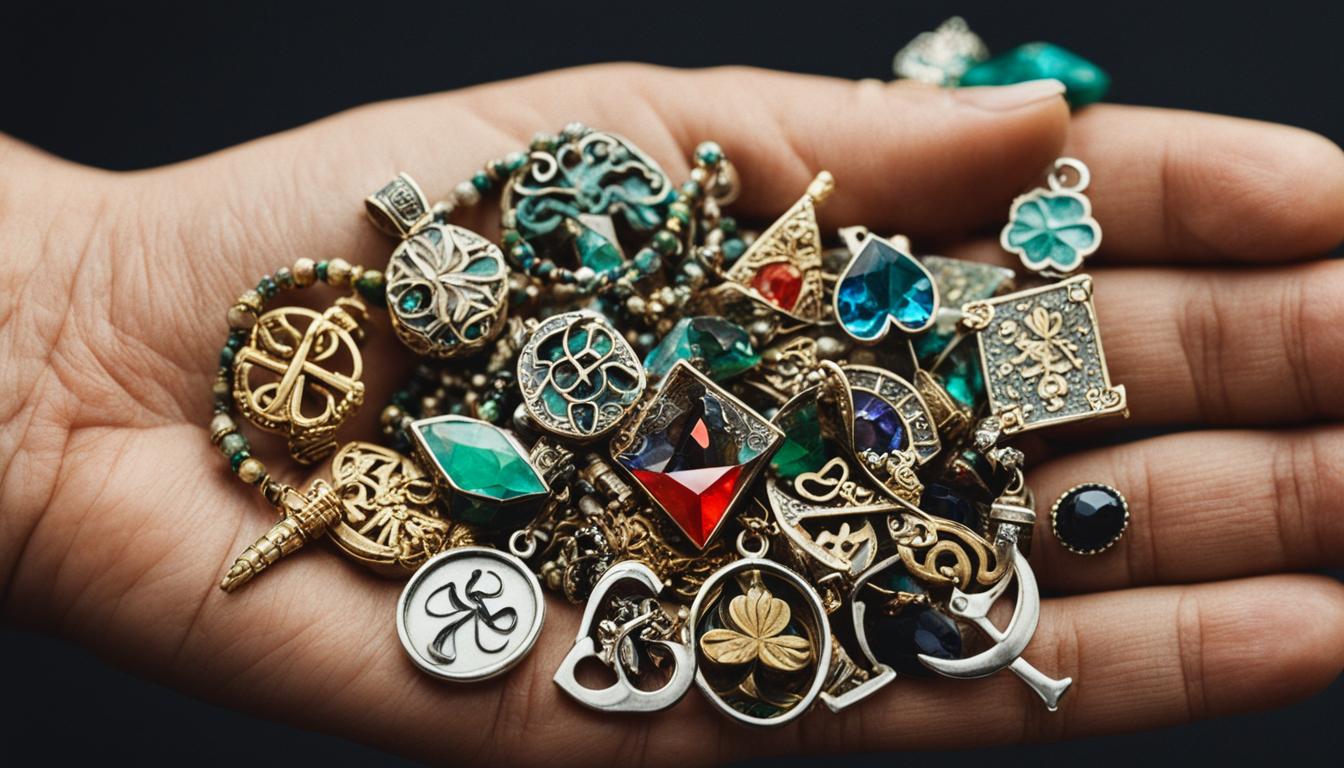Originally posted on January 9, 2024 @ 5:49 am
Jewelry has always been entwined with human culture, symbolizing beauty, wealth, and personal expression. However, along with its allure, jewelry has also acquired a collection of superstitions and beliefs about its connection to luck. In this article, we will explore some common myths and superstitions surrounding jewelry and uncover the truth behind them. Prepare to be amazed as we debunk these unlucky jewelry myths!
Key Takeaways
- Superstitions about jewelry and luck have been ingrained in our culture but are often unfounded.
- Opals, despite their undeserved reputation for bad luck, were considered lucky in ancient times.
- Diamonds may be highly prized, but they are not the rarest gemstones.
- Diamonds are not indestructible and should be treated with care.
- The traditional breath test for determining diamond authenticity is unreliable.
Opals Are Not Bad Luck, They’re Beautiful Gems
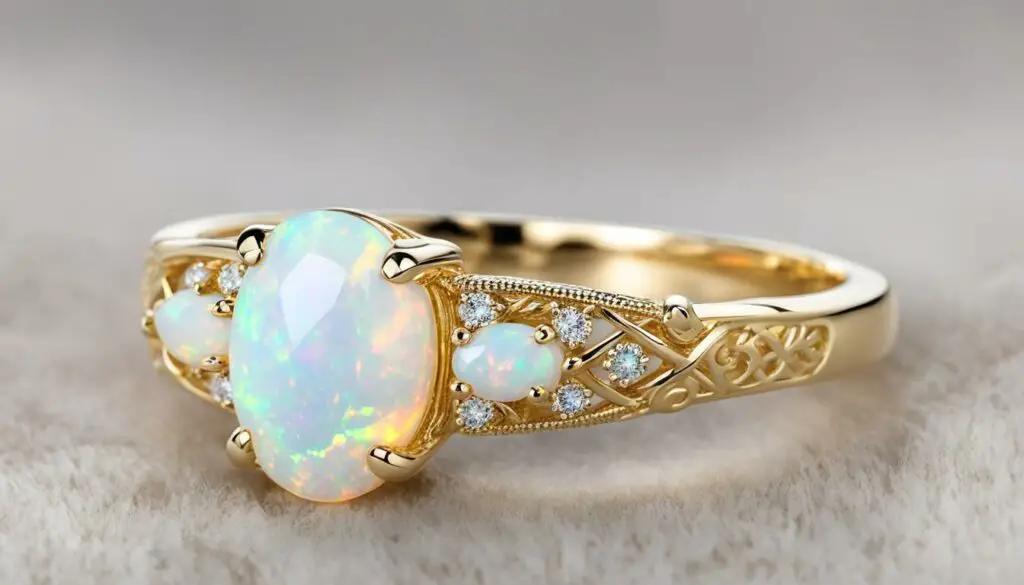
Despite the superstition that opals bring bad luck, their reputation is undeserved. Opals were actually considered lucky in ancient times and were treasured for their fiery flash. The belief that they are unlucky arose as a result of a negative marketing campaign. Opals are beautiful gemstones that can be worn with confidence and should not be associated with bad luck.
Opals are known for their stunning play of colors, called opalescence, which creates an iridescent effect. The unique patterns and hues found in opals make each stone truly one-of-a-kind. Opal jewelry is a popular choice for those who appreciate its natural beauty and want to stand out from the crowd.
“Opals are the most beautiful and mysterious of all gemstones.”
Opal superstitions have been prevalent for centuries, but the truth is that opals are no different from any other gemstone. Like any piece of jewelry, opals should be cared for and stored properly to maintain their brilliance and luster. With proper handling, opals can be enjoyed for generations to come.
The Origin of Opal Superstitions
The belief that opals bring bad luck can be traced back to a novel published in the 19th century. In Sir Walter Scott’s “Anne of Geierstein,” a character wears an enchanted opal that turns pale and brings her misfortune. This fictional story led to a widespread fear of opals and fueled the superstition.
| Opal Superstitions | Reality |
|---|---|
| Opals are bad luck | Opals are beautiful gemstones with no inherent luck |
| Opals bring misfortune | Opals can be worn without negative consequences |
| Opals should be avoided | Opals can be enjoyed and cherished like any other gemstone |
It’s important to separate fact from fiction and recognize that opals have been revered in many cultures throughout history. Ancient Romans believed opals were a symbol of hope and purity, while Arab folklore regarded them as falling stars transformed into gemstones. Opals have been associated with love, passion, and creativity, making them a meaningful choice for jewelry.
When purchasing opal jewelry, it’s essential to buy from reputable sources and ensure the stone is genuine. Opals come in different varieties, including black opals, white opals, and fire opals, each with its own unique characteristics and value. By educating ourselves and dispelling superstitions, we can appreciate the true beauty of opals and enjoy them for their natural splendor.
Diamonds Are Not the Rarest Gems
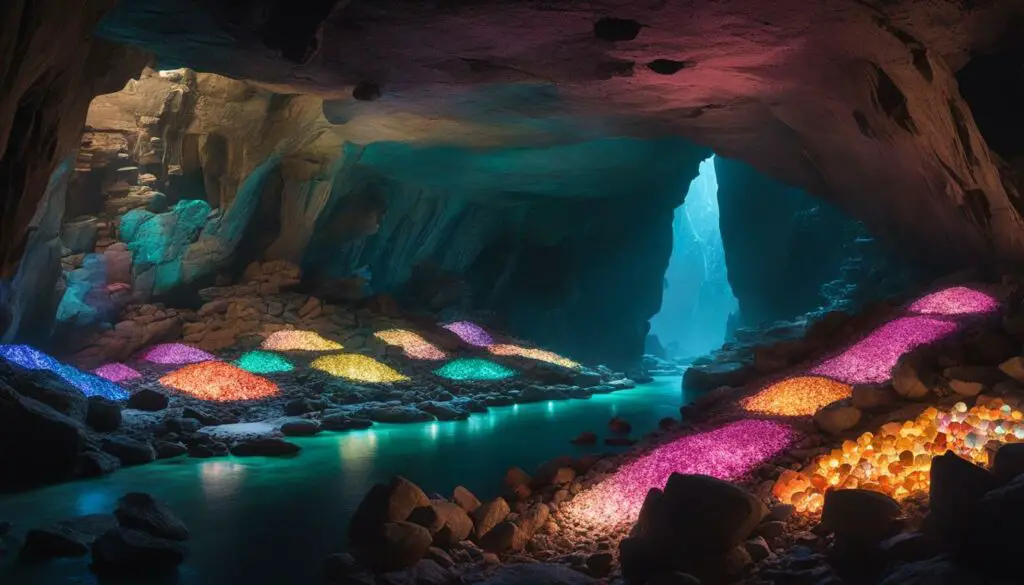
While diamonds are highly prized and valuable, they are not actually the rarest gems. Other gemstones like painite, star taaffeite, and alexandrite are considered rarer than diamonds. However, diamonds continue to be sought after and cherished for their beauty and symbolism.
When it comes to precious gemstones, diamonds often steal the spotlight. Their dazzling brilliance and durability have made them the go-to choice for engagement rings and other significant jewelry pieces. But are diamonds truly the rarest of them all?
No, they’re not.
While diamonds are undeniably precious and have captured the hearts of many, there are other gemstones that surpass them in rarity. Let’s take a look at some of these fascinating gems:
Painite
Painite is often hailed as one of the rarest gemstones on Earth. It was once believed to be the rarest mineral in the world, with only a handful of specimens known to exist. Its unique brownish-red color and exceptional beauty make it highly sought after by collectors and gem enthusiasts.
Star Taaffeite
Star taaffeite is an incredibly rare and stunning gemstone. Its rarity is due to the fact that it was initially mistaken for spinel, causing many to overlook its true identity. With its mesmerizing pink and purple hues, star taaffeite continues to captivate gem lovers and connoisseurs.
Alexandrite
Alexandrite is a rare and mesmerizing gemstone renowned for its color-changing properties. Under daylight, it exhibits a green or blue-green hue, while under incandescent light, it transforms to a vibrant red or purplish-red. This unique phenomenon has earned alexandrite the nickname “emerald by day, ruby by night.”
Although diamonds may not be the rarest gemstones, they remain highly valuable and cherished in the world of jewelry. Their timeless elegance, exceptional hardness, and enduring symbolism have made them a symbol of love and commitment. Diamonds come in various colors, sizes, and cuts, catering to a wide range of preferences and budgets.
So, while diamonds may not be the rarest gemstones, their allure and beauty are undeniable. Whether adorning a engagement ring, a pair of earrings, or a necklace, diamonds continue to be treasured for their enduring qualities and undeniable charm.
| Gemstone | Rarity Level |
|---|---|
| Diamonds | Highly prized and valuable |
| Painite | Considered one of the rarest gemstones |
| Star Taaffeite | Incredibly rare and captivating |
| Alexandrite | Renowned for its color-changing properties |
Diamonds Are Not Indestructible
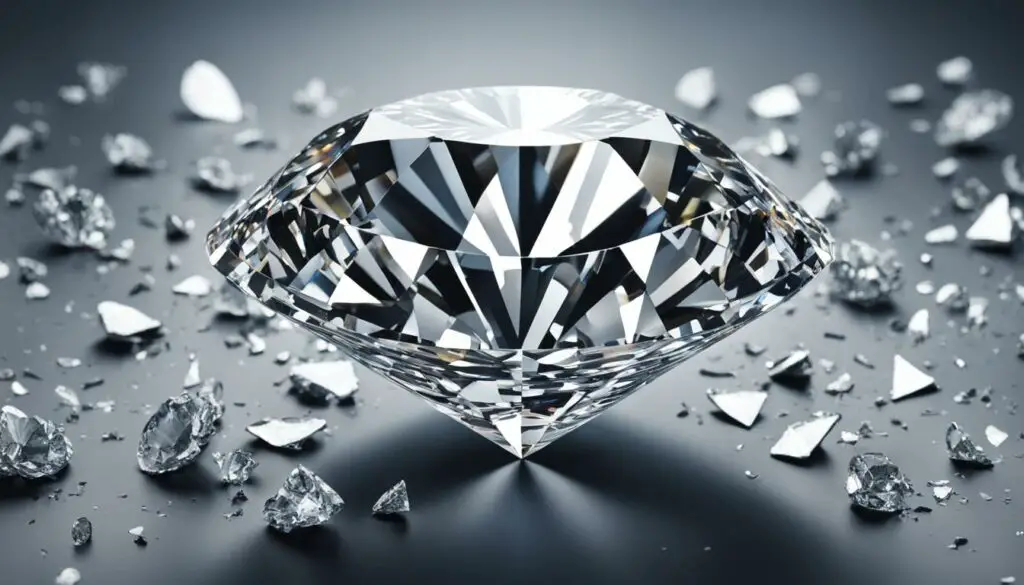
While diamonds are known for their exceptional hardness, they are not invincible. Contrary to popular belief, diamonds can get scratched and even crack if subjected to enough force. It is important to handle and care for diamonds properly to maintain their brilliance and beauty.
Diamonds are ranked as the hardest mineral on the Mohs scale, scoring a perfect 10. This hardness makes diamonds durable and resistant to scratching from most materials. However, this does not mean they are completely impervious to damage.
When diamonds come into contact with other diamonds or certain crystal structures, they can scratch each other. The integrity of a diamond can also be compromised if it experiences a significant impact, such as being struck by a hard object. While rare, these instances can result in cracks or chips on the diamond’s surface.
Proper diamond care is crucial for preserving their beauty and longevity. Here are some tips to help you keep your diamonds in pristine condition:
- Avoid wearing diamond jewelry during activities that could subject it to unnecessary risks, such as sports or heavy manual labor.
- Remove diamond jewelry before engaging in any tasks that involve chemicals or abrasive materials.
- Regularly clean your diamonds using mild soap and warm water, or seek professional cleaning from a trusted jeweler.
- Store your diamond jewelry individually in a soft fabric pouch or jewelry box to prevent scratching or damage from other pieces.
By following these care guidelines, you can help ensure that your diamonds stay radiant and stunning for years to come.
Expert Insight:
“While diamonds are incredibly durable, they are not indestructible. When it comes to diamonds, proper care is essential to prevent scratches, chips, or other damage. It’s also important to have your diamonds regularly inspected and maintained by a professional jeweler to address any potential issues early on.” – Gemologist Jane Williams
Diamond Hardness Comparison
Let’s take a closer look at the hardness of diamonds compared to other popular gemstones:
| Gemstone | Mohs Hardness Scale |
|---|---|
| Diamond | 10 |
| Sapphire | 9 |
| Ruby | 9 |
| Emerald | 7.5-8 |
| Topaz | 8 |
As seen in the table above, diamonds reign supreme as the hardest gemstone on the Mohs scale. While sapphires and rubies come close in terms of hardness, diamonds still hold the top spot.
It’s important to note that hardness does not necessarily equate to durability in terms of a gemstone’s ability to withstand wear and tear. Factors like toughness, cleavage, and the overall structural integrity of a gemstone also play a role in its resilience.
Breathe On It? Not a Reliable Test for Synthetic Diamonds
When it comes to determining the authenticity of a diamond, the breath test, also known as the fog test, is not a reliable method. This popular myth suggests that breathing on a diamond will cause it to fog up instantly, indicating that it is a synthetic diamond. However, this test is misleading and can lead to false conclusions.
It’s important to note that not all foggy diamonds are synthetic. Other gemstones, such as moissanite and sapphire, can also fog up due to their high thermal conductivity. This means that the fog test cannot accurately distinguish between synthetic diamonds and other gemstones.
To ensure the authenticity of a diamond, it is recommended to consult a trusted jeweler who has the expertise and equipment to accurately assess the gemstone. Professional jewelers use advanced techniques such as the diamond test, where they examine the gemstone’s unique properties to determine its authenticity.
While the breath test may seem convenient and accessible, it is not a reliable indicator of a diamond’s authenticity. Relying solely on this method can lead to costly mistakes and missed opportunities to own genuine diamonds.
Comparing Diamond Tests
| Diamond Test | Accuracy | Reliability | Professional Verification |
|---|---|---|---|
| Breath Test | Low | Unreliable | No |
| Diamond Test by Jeweler | High | Reliable | Yes |
| Synthesis Test | High | Reliable | Yes |
“While the breath test may seem convenient and accessible, it is not a reliable indicator of a diamond’s authenticity.”
As shown in the table above, the breath test falls short in accuracy and reliability compared to professional diamond tests. To avoid the risk of purchasing synthetic diamonds unknowingly, it is crucial to consult a trusted jeweler who can provide professional verification.
Remember, the beauty and allure of diamonds are not diminished by their origin. Synthetic diamonds are crafted with advanced technology and possess their own unique qualities. Whether natural or synthetic, diamonds continue to capture our hearts with their brilliance and timeless elegance.
Zircons Are Not Artificial Gems
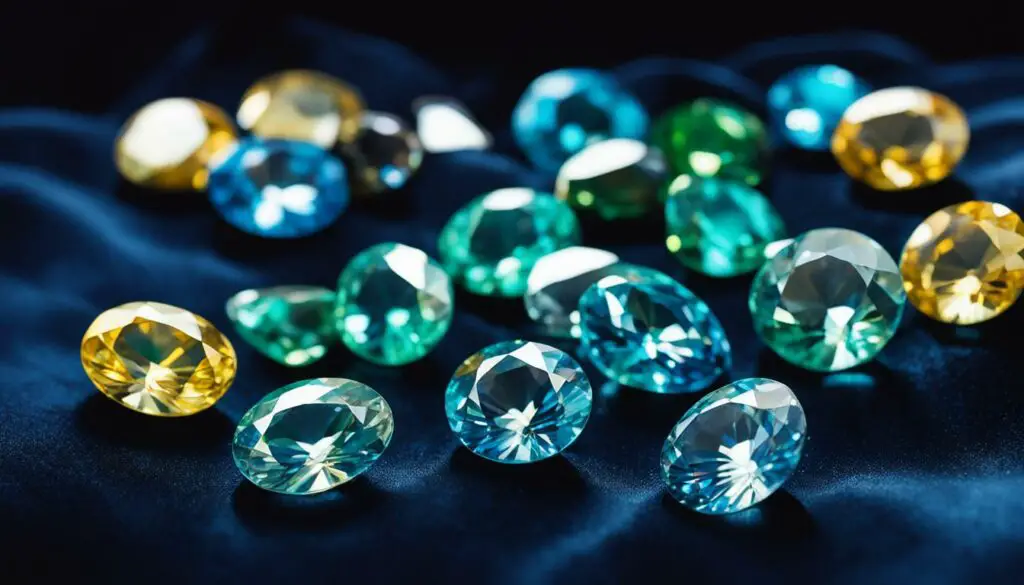
There is a misconception that zircon stones are artificial. However, cubic zirconia is the artificial gem often mistaken for zircon. In reality, zircon is a natural gemstone that has been used for centuries. It comes in various colors and is loved for its brilliance and optical properties.
Contrary to popular belief, zircons are not artificial gems like cubic zirconia. Zircon is a naturally occurring mineral that forms in igneous rocks and can be found in various locations around the world, including Cambodia, Myanmar, and Sri Lanka. It has been used in jewelry for centuries and is prized for its beauty and unique properties.
Zircons come in a range of colors, including blue, yellow, green, and brown. The most valuable and sought-after zircons are typically the blue ones, known as “starlite” or “star zircons,” which exhibit an asterism or star-like effect when properly cut and polished.
While zircons may not have the same level of popularity as diamonds or other gemstones, they offer a stunning alternative for those looking for a unique and colorful option. Zircon jewelry can add a vibrant touch to any collection, and its affordability compared to other gemstones makes it an attractive choice for those on a budget.
Key facts about zircons:
- Zircon is a naturally occurring gemstone.
- It comes in various colors, including blue, yellow, green, and brown.
- Blue zircons with asterism are the most valuable.
- Zircons have been used in jewelry for centuries.
Next, we’ll discuss the distinction between zircons and cubic zirconia to clear up any further confusion.
Zircons vs. Cubic Zirconia
While zircons and cubic zirconia may sound similar, they are distinct gemstones with different chemical compositions and properties.
Cubic zirconia, often abbreviated as CZ, is a synthetic gemstone that was developed in the 1970s as an affordable alternative to diamonds. It is made from cubic crystalline form of zirconium dioxide (ZrO2) and is known for its diamond-like appearance and brilliance.
Unlike zircon, cubic zirconia does not occur naturally. It is created in a laboratory setting under controlled conditions. Due to its affordability and diamond-like appearance, cubic zirconia became popular as a diamond simulant.
However, it’s important not to confuse cubic zirconia with zircon. Zircons are genuine gemstones with their own unique properties, while cubic zirconia is a man-made material designed to mimic the look of diamonds.
| Zircons | Cubic Zirconia |
|---|---|
| Naturally occurring gemstone | Synthetic gemstone |
| Comes in various colors | Typically colorless, but can be coated to resemble different colors |
| Forms in igneous rocks | Created in a laboratory |
| Priced based on color, clarity, and size | Generally more affordable than natural gemstones |
As you can see, there are significant differences between zircons and cubic zirconia. Understanding these distinctions can help you make informed decisions when choosing gemstone jewelry.
Remember, zircons are natural gemstones with their own unique beauty, while cubic zirconia is a synthetic material designed to imitate diamonds.
Size Doesn’t Always Determine Value

The belief that the larger the gemstone, the more expensive it is, is not always true. Other factors like clarity, cut, carat weight, and color also play a significant role in determining the overall value of a gemstone. A smaller gemstone with exceptional quality may be more valuable than a larger one with inferior characteristics.
When it comes to gemstone value, there are several key factors to consider:
- Clarity: The absence of inclusions or flaws within a gemstone can significantly increase its value.
- Cut: A well-cut gemstone reflects light properly, enhancing its brilliance and value.
- Carat Weight: While larger gemstones are often more valuable, a high-quality smaller gemstone can be equally or more valuable than a larger one.
- Color: The color of a gemstone can greatly influence its value. Certain colors, like rare fancy diamonds, can command a premium price.
It’s important to remember that each gemstone has its own unique value factors. For example, color is crucial for evaluating rubies and sapphires, while clarity is a significant factor in determining the value of emeralds. The overall quality, rarity, and market demand also impact gemstone prices.
Size alone does not determine the value of a gemstone. It’s essential to consider all the factors that contribute to its beauty and rarity.
Here is a visual representation of how different factors impact the value of gemstones:
| Factor | Impact on Gemstone Value |
|---|---|
| Clarity | Higher clarity increases value |
| Cut | Well-cut gemstones fetch higher prices |
| Carat Weight | Higher weight can increase value, but exceptional quality can overshadow size |
| Color | Rare colors or intense hues can significantly enhance value |
Remember, when purchasing a gemstone, it’s essential to consider all the factors that contribute to its value. Size should not be the sole determining factor, as smaller gemstones with exceptional quality can be equally or more valuable than larger ones with inferior characteristics.
The Distinction Between Precious and Semiprecious Gems is Meaningless

The gemstone industry has long categorized stones as either precious or semiprecious, based on their perceived value and rarity. However, this distinction is arbitrary and lacks a definitive meaning.
It is important to note that some semiprecious stones are actually rarer and more valuable than certain precious gems. For example, tanzanite, a semiprecious stone, is found in only one location and is highly coveted for its vibrant blue color. In contrast, some precious gems, like amethyst or peridot, are more abundant and less valuable.
Moreover, the labeling of gemstones as precious or semiprecious can lead to consumer confusion. This outdated classification system may give the impression that semiprecious stones are of lesser quality or value, which is not always the case. Gemstones should be evaluated based on their individual characteristics, including color, clarity, cut, and carat weight, rather than their classification as precious or semiprecious.
Industry experts are challenging the validity of the precious and semiprecious gemstone classification. They argue for a more comprehensive and holistic approach to gemstone labeling that takes into account all relevant factors that contribute to their value. By eliminating the arbitrary labeling of gems as precious or semiprecious, consumers can make more informed decisions based on the quality and uniqueness of the stone itself.
The Illusion of Gemstone Value
“The distinction between precious and semiprecious is a marketing concept that has no basis in gemological or mineralogical science.” – GIA (Gemological Institute of America)
The Gemological Institute of America (GIA), one of the leading authorities in gemstone grading, acknowledges that the precious and semiprecious classification is purely a marketing concept. The value of a gemstone is determined by a combination of factors including rarity, beauty, and durability, rather than its categorization as precious or semiprecious.
| Gemstone | Rarity | Value |
|---|---|---|
| Tanzanite | Rare | High |
| Diamond | Common | Varies |
| Amethyst | Abundant | Medium |
As shown in the table above, the value of a gemstone is not solely determined by its classification as precious or semiprecious. Instead, it is influenced by a combination of factors such as rarity and desirability among buyers. A semiprecious stone like tanzanite can be rarer and more valuable than a common precious gem like a diamond.
It’s important for consumers to look beyond the precious and semiprecious categorization and consider the individual characteristics, rarity, and beauty of a gemstone when determining its value. By doing so, they can make informed choices and truly appreciate the allure of each unique gemstone.
Biting Gold Won’t Determine Its Authenticity
The idea that biting gold can determine its authenticity is a common myth. Although gold is relatively soft and can be marked by teeth, this test is not a reliable method for determining the authenticity of gold. Other metals, such as lead, can also leave tooth imprints similar to those left by gold. Therefore, relying on the biting gold test alone is not sufficient to determine if gold is genuine or not.
If you want to ensure the authenticity of your gold, it’s best to consult a trusted jeweler or use specialized testing equipment. Jewelers have the expertise and knowledge to perform accurate tests, such as acid testing, to determine the purity of gold. Additionally, there are portable gold authenticity testing devices available that use advanced technology to provide accurate results.
Remember, relying on the biting gold test alone can lead to inaccurate assessments of gold authenticity. It’s always recommended to seek professional guidance or use reliable testing methods to guarantee the authenticity of your gold.
Gold Comes in More Than Just Yellow

While yellow gold is the most well-known color, gold can be alloyed with other metals to create different hues. White gold, rose gold, and even red, blue, and green gold are all variations of the metal. These alloyed golds are still valuable and beautiful in their own right.
When pure gold is mixed with other metals, it creates gold alloys with distinct colors and properties. The addition of metals like silver, nickel, or palladium results in white gold, which has a silvery-white appearance. Rose gold, on the other hand, is created by combining gold with copper, giving it a warm, pinkish hue.
Image:
Gold alloys can also be created with unique colors to suit individual preferences. Red gold, also known as rose gold, contains a higher percentage of copper, giving it a rich reddish hue. Blue gold, achieved by adding indium or iron, has a stunning blue color. Green gold, which is a combination of gold, silver, and sometimes zinc, displays a vibrant green shade.
The variety of gold colors allows individuals to choose jewelry that matches their personal style and taste. Whether it’s a classic yellow gold piece or a contemporary white gold design, gold in all its colors remains a cherished and sought-after metal.
Pearls Don’t Dissolve Easily in Vinegar
The belief that pearls can easily dissolve in vinegar is a myth. While there is some truth to the idea that pearls can dissolve in acidic solutions like vinegar, it is a slow process that takes days or even hours depending on the conditions. The story of Cleopatra dissolving pearls in vinegar for a banquet is more fiction than fact.
Pearls, known for their exquisite beauty and iridescence, are formed within the soft tissues of mollusks. The delicate layers of nacre that make up a pearl give it its lustrous appearance. While acidic substances like vinegar can potentially harm pearls, it would require prolonged exposure to fully dissolve them.
It’s important to care for your pearls properly to maintain their luster and beauty. Avoid exposing them to harsh chemicals, including vinegar, and protect them from scratches and impact. Clean pearls gently with a soft cloth or a mild solution specifically designed for pearl jewelry. Regular maintenance and professional cleaning will help ensure the longevity of your pearls.
“Contrary to popular belief, pearls do not dissolve easily in vinegar. While it’s essential to take precautions in caring for these delicate gems, the myth of pearl dissolution in vinegar is unfounded.”
If you’re unsure about the care of your pearl jewelry or want to have them professionally cleaned, it’s best to consult a reputable jeweler. They can provide guidance on the proper maintenance and care of your pearls to preserve their beauty for generations to come.
Common Myths About Pearl Dissolution
| Myth | Reality |
|---|---|
| Pearls dissolve quickly in vinegar. | Pearls dissolve slowly, requiring prolonged exposure to vinegar. |
| Acidic substances can easily damage pearls. | Pearls can withstand mild exposure to acidic substances, but prolonged exposure should be avoided. |
| Cleopatra dissolved pearls in vinegar for a banquet. | The story of Cleopatra dissolving pearls in vinegar is likely a work of fiction. |
Conclusion
After exploring various myths and superstitions surrounding jewelry, it is clear that many popular beliefs about luck and jewelry have been debunked. From opals to diamonds, gold to pearls, these beloved accessories have been subjected to unfounded misconceptions for far too long.
It is important to base your jewelry choices on personal preferences and the quality of the materials rather than superstitions. Whether it’s an opal necklace or a diamond ring, the truth about jewelry shines through when we appreciate their beauty and craftsmanship.
So, the next time you admire a piece of jewelry, remember that its value lies not in the luck it brings, but in the joy it brings to your life. Embrace the truth about jewelry and wear your favorite pieces with confidence, knowing that they are a reflection of your unique style and personality.
FAQ
Can wearing jewelry bring bad luck?
No, the belief that jewelry can bring bad luck is a superstition. There is no evidence to support this claim.
What are some common superstitions about jewelry?
Some common superstitions about jewelry include the belief that opals are unlucky, that biting gold can determine its authenticity, and that pearls can easily dissolve in vinegar.
Are opals really bad luck?
No, opals are not bad luck. In fact, they were considered lucky in ancient times and were treasured for their fiery flash.
Are diamonds the rarest gems?
No, diamonds are not the rarest gems. Other gemstones like painite, star taaffeite, and alexandrite are considered rarer than diamonds.
Are diamonds indestructible?
No, diamonds are not indestructible. While they are the hardest mineral on the Mohs scale, they can still be damaged and need to be treated with care.
Is the breath test a reliable method for determining if a diamond is synthetic?
No, the breath test is not a reliable method for determining if a diamond is synthetic. Other gemstones like moissanite and sapphire can also fog up due to their high thermal conductivity.
Are zircon stones artificial?
No, zircon stones are not artificial. Cubic zirconia is the artificial gem often mistaken for zircon. Zircon is a natural gemstone that has been used for centuries.
Does the size of a gemstone determine its value?
No, the size of a gemstone does not always determine its value. Other factors like clarity, cut, carat weight, and color also play a significant role in determining the overall value of a gemstone.
What is the distinction between precious and semiprecious gems?
The distinction between precious and semiprecious gems is arbitrary and has no definitive meaning. Some semiprecious stones are rarer and more valuable than precious gems.
Can biting gold determine its authenticity?
No, biting gold is not a reliable test for determining its authenticity. Other metals like lead can also leave tooth imprints. It’s best to consult a trusted jeweler or use specialized testing equipment.
Does gold only come in yellow?
No, gold can be alloyed with other metals to create different colors. White gold, rose gold, and even red, blue, and green gold are all variations of the metal.
Do pearls dissolve easily in vinegar?
No, pearls do not easily dissolve in vinegar. While they can dissolve over an extended period, it takes days or even hours depending on the conditions. Proper care is important to maintain their luster and beauty.
Are jewelry superstitions and myths true?
No, many common beliefs about jewelry and luck are simply unfounded. It’s important to base jewelry choices on personal preferences and the quality of the materials rather than superstitions.
